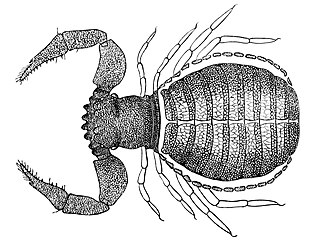
Pseudoscorpions, also known as false scorpions or book scorpions, are small, scorpion-like arachnids belonging to the order Pseudoscorpiones, also known as Pseudoscorpionida or Chelonethida.

Feaellidae is a family of pseudoscorpions, first described by Edvard Ellingsen in 1906.
Feaella callani is a species of pseudoscorpion in the Feaellidae family. It is endemic to Australia. It was described in 2016 by Australian arachnologists Mark Harvey, Kym Abrams, Amber Beavis, Mia Hillyer and Joel Huey.
Feaella linetteae is a species of pseudoscorpion in the Feaellidae family. It is endemic to Australia. It was described in 2016 by Australian arachnologists Mark Harvey, Kym Abrams, Amber Beavis, Mia Hillyer and Joel Huey.
Feaella tealei is a species of pseudoscorpion in the Feaellidae family. It is endemic to Australia. It was described in 2016 by Australian arachnologists Mark Harvey, Kym Abrams, Amber Beavis, Mia Hillyer and Joel Huey.
Indohya panops is a species of pseudoscorpion in the Hyidae family. It is endemic to Australia. It was described in 1993 by Australian arachnologist Mark Harvey.
Indohya pusilla is a species of pseudoscorpion in the Hyidae family. It is endemic to Australia. It was described in 1993 by Australian arachnologist Mark Harvey.
Indohya typhlops is a species of pseudoscorpion in the Hyidae family. It is endemic to Australia. It was described in 1993 by Australian arachnologist Mark Harvey.
Anysrius brochus is a species of pseudoscorpion in the Hyidae family. It is endemic to Australia. It was described in 1998 by Australian arachnologist Mark Harvey. The specific epithet brochus refers to the cheliceral teeth of the male.
Ideoblothrus pisolitus is a species of pseudoscorpion in the Syarinidae family. It is endemic to Australia. It was described in 1991 by Australian arachnologists Mark Harvey and Karen Edward. The specific epithet pisolitus refers to the pisolitic geology of the type locality.
Geogarypus rhantus is a species of pseudoscorpion in the Geogarypidae family. It was described in 1981 by Australian arachnologist Mark Harvey. The specific epithet rhantus comes from the Greek rhantos, with reference to the star-shaped granulations on the carapace and pedipalps.
Geogarypus taylori is a species of pseudoscorpion in the Geogarypidae family. It is endemic to Australia. It was described in 1986 by Australian arachnologist Mark Harvey.
Synsphyronus gurdoni is a species of pseudoscorpion in the Garypidae family. It is endemic to Australia. It was described in 2015 by Australian arachnologist Mark Harvey. The specific epithet gurdoni honours John Gurdon for his contributions to developmental biology.
Americhernes muchmorei is a species of pseudoscorpion in the Chernetidae family. It is endemic to Australia. It was described in 1990 by Australian arachnologist Mark Harvey. The specific epithet muchmorei honours American arachnologist William Muchmore (1920–2017) who described the genus Americhernes.
Americhernes orestes is a species of pseudoscorpion in the Chernetidae family. It is endemic to Australia. It was described in 1990 by Australian arachnologist Mark Harvey. The specific epithet orestes refers to the species’ presence on one of Queensland's highest mountains.
Satrapanus is a monotypic genus of pseudoscorpions in the Chernetidae family. It is endemic to Australia's Lord Howe Island in the Tasman Sea. It was described in 2007 by Australian arachnologists Mark Harvey and Erich Volschenk. The generic epithet comes from the Latin satrapa with reference to the pseudoscorpion being the only known species of the genus on the island.
Linnaeolpium is a monotypic genus of pseudoscorpions in the Olpiidae family. It was described in 2008 by Australian arachnologists Mark Harvey and Mei Chen Leng. The genus name Linnaeolpium honours Carl Linnaeus (1707–1778), founder of modern taxonomy, in combination with the generic name Olpium.
Thenmus aigialites is a species of pseudoscorpion in the Menthidae family. It is endemic to Australia. It was described in 1990 by Australian arachnologist Mark Harvey.
Thenmus augustus is a species of pseudoscorpion in the Menthidae family. It is endemic to Australia. It was described in 2006 by Australian arachnologist Mark Harvey. The specific epithet augustus refers to the type locality.
Pycnodithella harveyi is a species of pseudoscorpion in the Chthoniidae family. It is endemic to Australia. It was described in 1989 by Australian athlete and zoologist Clarice Kennedy. The specific epithet harveyi honours arachnologist Mark Harvey for his contributions to the knowledge of the pseudoscorpion fauna of Australia.

